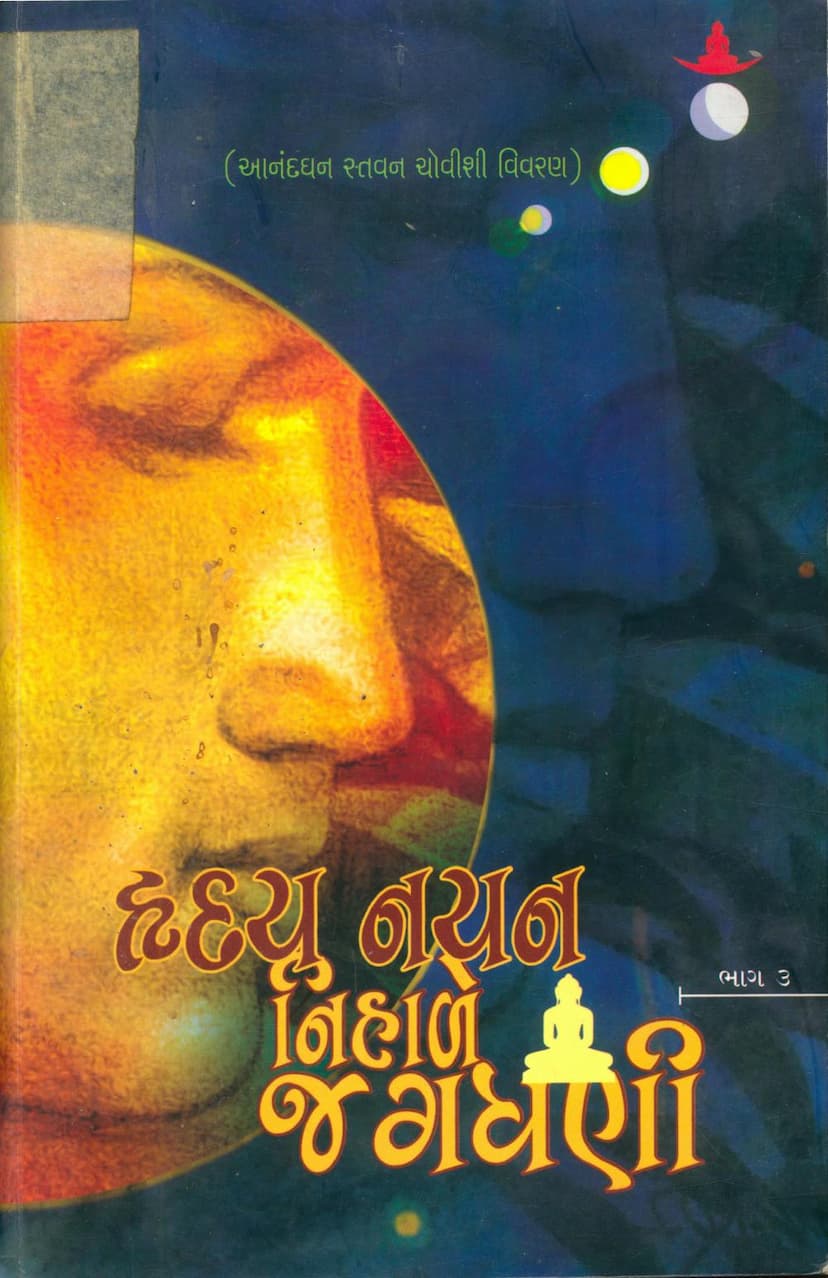Hriday Nayan Nihale Jagdhani Part 03
Added to library: September 1, 2025

Summary
This Jain text, "Hriday Nayan Nihale Jagdhani Part 03," authored by Anandghan and Muktidarshanvijay, published by Shri Matunga Shwetambar Murtipujak Tapagaccha Jain Sangh, is a commentary on the "Anandghan Stavana Chovishi." This third volume delves deeply into the spiritual and philosophical aspects of Jainism, specifically through the lens of devotional hymns (stavana) composed by the Yogi Raj Shri Anandghanji.
The book is structured around a detailed explanation of each of the 26 hymns, with each section covering the hymn's number, line count, primary theme (Pradhan Soor), and the commentary's page number. The content of the commentary, as presented in the provided excerpts, focuses heavily on interpreting these hymns in a profound spiritual and allegorical manner.
Key Themes and Concepts Discussed:
- The Nature of the Soul and the Divine: The text frequently refers to the soul (Atman) as the ultimate reality, the "Lord of the Universe" (Jagatdhani), and the ultimate goal of spiritual practice. It emphasizes understanding the soul's true nature beyond worldly perceptions and the limitations of the physical body.
- Rejection of External Ritualism for Inner Realization: While acknowledging external forms of worship, the commentary stresses that true devotion and spiritual progress lie in internal contemplation and self-realization. The hymns are presented not just as devotional songs but as pathways to understanding the soul's inherent divinity.
- The Significance of the Tirthankaras: The text elaborates on the lives and teachings of the Tirthankaras, particularly focusing on their attributes and their role as guides to liberation. The commentary on Shri Naminath Swami, for instance, extensively discusses the philosophical underpinnings of various Indian darshanas (philosophical schools) and their place within the broader Jain framework, highlighting the inclusive and all-encompassing nature of Jain philosophy.
- The Path to Liberation (Moksha): The commentary repeatedly emphasizes that liberation is attained through self-effort, wisdom, right conduct, and the eradication of karmic bondage. It discusses concepts like samyaktva (right faith), which is the foundation of the path, followed by right knowledge and right conduct.
- The Importance of Svadhyaya and Guru: The text underscores the crucial role of self-study (Svadhyaya) and the guidance of a true spiritual teacher (Guru) in understanding the profound truths of Jainism. The commentary on Shri Neminath Swami's hymn highlights the importance of inner contemplation and seeking the divine within oneself, rather than solely through external means.
- The Philosophy of Anekantavada and Syadvada: The commentary, particularly in the discussion of Shri Naminath Swami's hymn, explains the Jain principles of Anekantavada (many-sidedness of reality) and Syadvada (conditional predication), demonstrating how Jainism encompasses and synthesizes various philosophical viewpoints without contradiction. This emphasizes the vastness and comprehensiveness of Jain thought.
- Inner Transformation over External Observances: The text repeatedly emphasizes that true spirituality is an inner transformation. The commentary on Shri Parshvanath Swami's hymn highlights that mere external actions or rituals are insufficient without the inner purification and realization of one's true nature.
- The Nature of Karma and Soul: The commentary touches upon the complex interplay of karma and the soul, explaining how ignorance and attachment lead to karmic bondage, and how wisdom and detachment lead to liberation. The discussion on Shri Mahavir Swami's hymn touches on the importance of right effort and the soul's inherent strength.
- The Concept of Divine Grace and Personal Effort: While acknowledging the role of divine grace, the text ultimately places emphasis on the individual's own efforts and understanding in their spiritual journey. The commentary on Shri Naminath Swami's hymn implicitly suggests that true realization comes from within.
- Metaphorical Interpretations: The hymns and their commentary often use metaphors and allegories to convey deep spiritual truths. For example, the concept of "home" represents the soul's true abode, and the search for the divine is portrayed as an inward journey.
Overall, "Hriday Nayan Nihale Jagdhani Part 03" appears to be a profound and comprehensive spiritual guide within the Jain tradition. It aims to lead the reader beyond mere intellectual understanding to a deeper, experiential realization of the soul's true nature and the path to liberation. The detailed analysis of each hymn, combined with philosophical insights, makes it a valuable resource for serious Jain scholars and practitioners seeking to deepen their spiritual understanding.